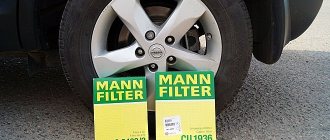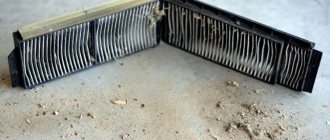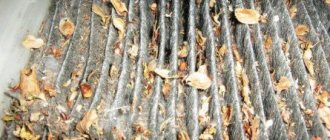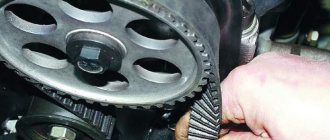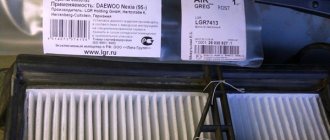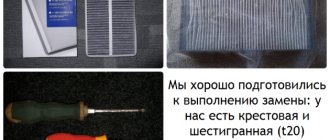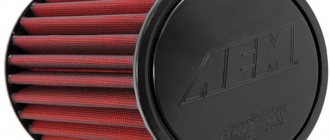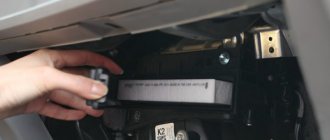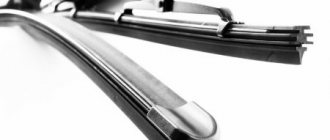Where is the cabin filter located in the Kia Rio?
The cabin filter is located in the Kia Rio, like in Sportage and Cerato, on the passenger side, behind the glove compartment. It is necessary to open the door; behind it there is an air duct outlet, onto which the cleaning element is attached. The air filter is located under the hood on the right side when facing the car.
You can also determine where the cabin filter is located on a gasoline Kia Rio using the technical manual that is included when purchasing the car.
Let's sum it up
There is no point in arguing about the quality of the filter for the KIA Rio 3, because this component is capable of protecting the health of the driver and his companions. Change the element when signs of contamination appear, which you can identify in a timely manner. We described above how to change the cabin filter. The procedure is not capable of taking 20 minutes of time, but it will provide the salon with clean air.
One of the advantages of maximum unification of conveyor production is the similarity of maintenance procedures for different cars of the same manufacturer, down to the smallest detail. For example, having replaced the cabin filter on a Kia Rio of 2-3 generations yourself, you can find that it is changed in a similar way on other Kia passenger cars of the same class.
Considering that this procedure is more than simple, there is no need to resort to the help of a car service: you can simply change the cabin filter yourself even without any experience
What types of cabin filters are there for Kia Rio?
In total, two types of cleaning elements can be distinguished:
- For rough cleaning – designed to block coarse dust and dirt. Apart from the price advantage, it has such disadvantages as short service life and fragility.
- For fine cleaning – blocks the smallest particles, prevents the penetration of external odors into the car. Made from synthetic materials.
There are also regular and carbon filters. The latter trap particles of harmful substances more efficiently.
Selecting a new part
Filters are sold in online automotive stores and large retail chains like AliExpress or eBay.
The most popular option are parts with article number 971334L000. The Kia filter also fits Hyundai cars. The part is an original carbon cabin air purifier, recommended for cars of the Rio line.
Of course, you can also look for offers from other manufacturers. They are all the same size, and there will be no problems with installation. It is worth noting that the technical superiority of the factory part over others has not been confirmed: they can filter air in the same way or in different ways. The choice remains with the buyer himself. In addition, you can select an element with or without a frame. The first option is necessary if it was damaged during removal.
Which filter to choose: original or analogue
Before replacing the 4th generation Kia Rio cabin filter, the driver needs to decide between the original and analog spare parts:
- The service life of high-quality products is allowed up to one and a half years. If you plan to do quiet and infrequent driving around the city, then this option is ideal.
- If the issue of replacement does not frighten the car owner, then for the price of an original spare part you can purchase several products of lower quality and replace them every 3-4 months.
Brands of original cleaning elements (some are supplied from the factory): NIPPART, Cangoo.
For pre-restyling models of 2012 (2009, 2010, 2011), only non-original spare parts for large filtration with article numbers MANN CU1828, VALEO 698681, TSN 9.7.117 are suitable.
How much does a filter cost?
Replacing the cabin filter for Kia Rio 2020 and 2020. release is not considered an overhead repair. The price ranges from 250 to 500 rubles for the analog coal version. The cost of a part with deep air purification starts from 600 rubles and reaches 1.5 thousand rubles.
When to change, what interior to install
To perform scheduled maintenance operations, there are regulations, as well as manufacturer recommendations. According to them, replacing the cabin filter of the Kia Rio III QB heating and air conditioning system should be done every 15,000 kilometers or once a year.
Considering that the operating conditions of the car in most cases will be far from ideal, experts advise performing this operation approximately twice as often, in spring and autumn.
Characteristic symptoms:
- Windows often fog up;
- the appearance of unpleasant odors in the cabin when the airflow is turned on;
- deterioration of the stove and air conditioner;
They may make you doubt that the filter element is coping with its tasks and an unscheduled replacement will be required. In principle, these symptoms should be relied upon when choosing the correct replacement interval.
Suitable sizes
When choosing a filter element, owners do not always use products recommended by the car manufacturer. Everyone has their own reasons for this, some say that the original is unreasonably expensive. Some people in the region sell only analogues, so there is a need to know the sizes by which you can subsequently make a selection:
- Height: 15 mm
- Width: 189 mm
- Length: 210 mm
As a rule, sometimes analogues for the Kia Rio III QB may be a few millimeters larger or smaller than the original, there is nothing wrong with that. And if the difference is measured in centimeters, then of course it’s worth looking for another option.
Selecting an original cabin filter
The manufacturer recommends using exclusively original consumables, which, in general, is not surprising. They themselves are of good quality and are widely available in car dealerships, but their price may seem overpriced to many car owners.
Regardless of the configuration, on all third-generation Kia Rios (including the restyled version), the manufacturer recommends installing a cabin air filter with article number 97133-4L000 (971334L000). Sometimes, instead of a filter, a mesh with number 97133-0C000 is installed; of course, it does not protect from dust, but only from debris getting into the impeller.
It is worth noting that sometimes consumables and other spare parts may be supplied to dealerships under different part numbers. Which can sometimes confuse those who want to purchase an original product.
When choosing between a dust and carbon product, car owners are advised to use a carbon filter element. This filter is more expensive, but it cleans the air much better.
It is easy to distinguish - the paper filter accordion is impregnated with a carbon composition, and therefore has a dark gray color. The filter cleans the air flow from dust, fine dirt, germs, bacteria and enhances the protection of your lungs.
Which analogues to choose
In addition to simple cabin filters, there are also carbon filters that filter the air more effectively, but they are more expensive. The advantage of coal SF is that it does not allow foreign odors coming from the road (street) to penetrate into the car interior.
But this filter element also has a drawback - air does not pass through it well. GodWill and Corteco carbon filters are of fairly high quality and are a good replacement for the original.
However, in some retail outlets the price of the original third-generation Kia Rio cabin filter may be greatly inflated. In this case, it makes sense to purchase a non-original consumable item. In particular, cabin filters are considered quite popular:
Conventional dust cabin filters
- Mann Filter CU21008 – high-tech consumables from a well-known manufacturer
- BIG filter GB-9971 – popular brand, good fine cleaning
- RU54 CF-931 – Russian manufacturer with an affordable price
Carbon cabin filters
- TSN 9.7.872 – high-quality and thick carbon coating
- BIG filter GB-9971/C – activated carbon
- Nevsky filter NF-6348C – normal quality, affordable price
It makes sense to take a closer look at the products of other companies - they also specialize in the production of high-quality consumables for passenger cars:
- Corteco
- Filtron
- SCT
- Sakura
- GoodWill
- Fram
- JS Asakashi
- Champion
- Zekkert
- Masuma
- Nipparts
- Purflux
- Knecht Mahle
- Nevsky filter
It is quite possible that sellers may recommend replacing the Rio III QB cabin filter with non-original cheap substitutes with a much smaller thickness. They are not worth buying, since their filtering characteristics are unlikely to be at the proper level.
Signs of a clogged filter on a Kia Rio
You can understand that the Kia Rio 4 or Sportage cabin filter needs to be replaced by the following signs:
- Extraneous unpleasant odors penetrate into the interior of the car, this is especially evident when the air conditioning is turned on: you can feel the soot, your nose itches from the dust.
- The amount of dust on the dashboard and seats increases even with the windows closed.
Also, when the filter is clogged, the amount of air that enters the cabin is reduced. This leads to accelerated fogging of the windshield and side windows.
How to diagnose the problem?
Here it will be useful to determine the true need to replace the part, as well as where it is located. Smells in the cabin cannot fully indicate the fact of a blockage.
Here you need to independently verify the degree of clogging of the filter component. And know how to change the cabin filter.
- Given the need for verification, we proceed to action. Open the glove compartment lid and unfasten the latches present inside, which are located on the side surfaces.
- Kia Rio 3 allows you to diagnose without resorting to special efforts. Here you will need to rotate the element 360 degrees and remove it towards you.
- In the second generation of the popular model, the clamps had a composite design, and considerable effort was required to loosen them.
- Let's continue. After deactivating the fasteners, the filter element appears before the eye.
- Removal requires simple dismantling of the latches, after which the cover becomes accessible.
- We set it aside to provide sufficient access to the frame of the filter element itself.
- Only after removing the frame will it be possible to remove the filter and assess the degree of contamination of its working surface. We determine the condition by color. For a gray filter, vacuuming will be sufficient. If the element shows a black or dark gray tint, then it will need to be replaced in order to stop the harmful effects on the health of the people present in the Kia Rio 3 cabin.
Cabin filter diagnostics
To understand whether you need to change the cabin filter on a Kia Rio 2020 model or any other, you don’t have to contact hired specialists. The diagnostic process follows from the previously described signs of blockage:
- Start the car and warm up the engine without turning on the heater.
- Turn on the heating system at maximum power.
- Place your hand against the air duct in the cabin.
- If the blown air does not correspond to the set temperature, it means that the filter is clogged and it does not allow you to quickly heat the interior of the car.
How to replace the cabin filter element of a Kia Rio with your own hands?
Before starting work, you will need to purchase the consumable item itself. The optimal solution would be to purchase a coal version, its catalog number is MS-6307.
From a technical point of view, even an inexperienced technician will not have any problems with how to remove the cabin filter on a Kia Rio and install a new one. The work can be done in your own garage, or just in the parking lot. The filter is located in the cabin, right behind the glove box.
Replacement algorithm:
- open the glove compartment and empty it;
- Find two plugs inside the compartment and remove them by first turning them counterclockwise. The glove box lid must be lowered and the right door open to create the space needed for work;
- after removing the plugs, a shelf with a filter secured on both sides with clamps will become visible;
- the latches are pulled towards themselves and carefully pressed out, the cover is removed;
- the old filter element is removed;
- a new part is inserted into the frame. If its linear dimensions are slightly wider than the frame, then the product can be trimmed along the edges. The arrow drawn on the fabric surface should be directed downwards during installation;
- then all the parts are returned to their places in the reverse order; when closing, the plugs are turned until they click.
After watching how to change the cabin filter of a Kia Rio in the video, the driver can easily carry out the replacement operation on his own, without wasting time and nerves on visiting a car repair shop.
Kia cars have always been famous for their ease of maintenance. The Rio model was no exception to the rule. It is also quite easy to replace the cabin filter on it, as on all other Kia cars.
Even a novice motorist who does not yet have experience in car maintenance can cope with this work. The process will take no more than 30 minutes.
How often should it be replaced?
The frequency with which the Kia Rio and Rio X-Line cabin filter changes depends on several factors:
- selected model;
- driving habits;
- vehicle mileage.
If you add up all the nuances, then it is recommended to change the cleaning element once a year, provided that the car travels no more than 30 thousand km during this time and the majority of trips are within the city.
If most of the operation involves driving on dusty country roads, then even the highest quality cleaning element is recommended to be replaced after 15 thousand km.
There are recommendations that replacing the cabin filter for Kia Rio 2014, 2020 and later models should be done twice a year: before winter and before summer. However, it needs to be changed only when there is less dirt on the roads.
What kind of gasoline to fill in Kia Rio - Car repair and maintenance
Often, car enthusiasts, when purchasing motor oil, pay attention to the base fluid: synthetic, semi-synthetic, mineral. At the same time, they do not pay attention to the class, type, and viscosity of the motor oil. Such actions can lead to premature failure of the power unit. It is correct to buy the lubricant specified in the car manual. In this article, we will look at the recommended engine oil for KIA RIO according to the owner's manual.
When selecting engine oil for a specific car model, engineers at the car manufacturer take into account the technical parameters of the engine and the operating conditions under which it will operate.
Carrying out appropriate tests for various lubricants on a specific engine allows you to choose the optimal motor oil that helps reduce fuel consumption and extend the life of the power unit.
Based on the test results, the car manufacturer includes the recommended engine oil for KIA RIO in the vehicle’s operating instructions. The manual indicates the viscosity characteristics and compliance of the lubricant with the requirements of the API, ILSAC, ACEA systems.
When selecting a lubricant for the Kia Rio, take into account the season outside the car. Motor oils designed for winter are more fluid than liquids designed for summer. You can buy all-season lubricant. It is also worth familiarizing yourself with the tolerances on the motor oil canister. The presence of approvals from the manufacturer of a specific car model indicates that the oil meets the requirements of the car manufacturer.
KIA RIO JB 2005-2011
- For gasoline engines:
- API quality class -SM or higher; in the absence of the specified motor oil, SL fluids can be used;
- according to the ILSAC standard - GF-4.
- In diesel power units:
- according to API specification - CH-4 or higher;
- in accordance with the ACEA system - B4.
According to Table 1, select a lubricant that is suitable in terms of viscosity characteristics, taking into account the temperature conditions outside the machine.
Table 1. Viscosity depending on the temperature range.
*1 - fuel mixture savings can be achieved by using motor oils that meet the following parameters:
- according to SAE 5W-20;
- according to the API system - SM;
- in accordance with ILSAC - GF-4.
From Table 1 it follows, for example, in the temperature range from -30 0 C (or less) to +50 0 C (or more) for gasoline engines, use 5W-20 or 5W-30 fluids. For diesel units, it is recommended to use 15W-40 at temperatures from -17 0 C to +50 0 C (or more). The temperature range for other types of lubricant is calculated similarly.
KIA RIO QB 2011-2014 and KIA RIO QB FL 2015-2017
Based on the operating instructions for the machine, for 1.4 l and 1.6 l engines running on gasoline, you need to use motor fluids that meet the specifications:
- according to API classification -SM or higher, in the absence of the specified oil, SL fluids can be used.;
- according to the ILSAC standard - GF-4 or higher.
The requirements for the viscosity characteristics of the oil are similar to KIA RIO JB 2005-2011, so the required lubricant can be selected from Table 1.
An oil with the following characteristics helps reduce fuel consumption:
- according to SAE 5W-20;
- in accordance with API - SM;
- according to ILSAC standards - GF-4.
Conclusion
Lubricants have different fluidity and chemical composition of additives. Therefore, it is better to use the recommended engine oil for KIA RIO. Filling with motor oil that does not meet the parameters reduces the performance of the engine and increases fuel consumption.
If the lubricant is too thick or thin, this will lead to deterioration in the protection of the power unit and its premature wear.
It is preferable to use original oils; if they are unavailable, it is permissible to use liquids that meet all the characteristics set out in the car manual.
Choosing the right engine oil will prevent wear and ensure the normal operation of your car engine. In this article we will tell you what kind of oil to pour into the Kia Rio engine. In addition, you will learn how to determine the frequency of replacement of lubricating fluid and oil filter and how to perform these works yourself.
[Hide]
About replacement frequency
The operating instructions, relevant for cars produced in 2010, 2011, 2012, 2013, 2014, 2020, 2020, recommend changing the oil every 15 thousand kilometers. However, in practice, this recommendation is only suitable for operating the machine in optimal conditions, which is not always feasible in Russia and the CIS countries.
City streets are overloaded, cars move at low speeds, and stand idle in traffic jams. In such conditions, the engines operate at idle speed for a long time, and this does not at all affect the speedometer readings.
Also, the replacement period is significantly affected by the quality of fuel at gas stations, which does not always meet the required parameters. Therefore, the optimal vehicle mileage between engine lubricant changes will be approximately 10 thousand km.
km, and when operating in difficult conditions it is reduced to 7–8 thousand km.
Some experts advise using the readings from the on-board computer when determining when to change the lubricant. With its help, you can easily find out the average speed of the car. If this figure is more than 50 km/h, you can safely operate the power unit up to a mileage of 15 thousand km. If it is in the area of 30 km/h, the mileage is reduced to 10 thousand km.
Watch a video about changing the oil from user Mikhail Knyazev.
THIS IS INTERESTING: Chevrolet Lanos oil change
Possible causes of oil consumption
This problem occurs even in completely new cars, but most often this “disease” accompanies cars with significant mileage.
Increased oil consumption can be caused by:
- the presence of leaks in the power unit;
- wear of the cylinder, pistons, rings;
- increased gap between guide bushings and valve stems;
Typical causes of such problems:
- improper operation of the machine;
- movement in dusty conditions;
- work for a long time at idle speed;
- frequent movement at high speeds.
Which oil is better to choose
The service life of any car engine depends on the quality of the lubricant used.
It can be difficult to make the right choice on your own, since trading platforms are filled with a large number of motor oils from different manufacturers and of different quality. Review the car manufacturer's recommendations, listen to the advice of experts, and only then decide what kind of oil to pour into the Kia Rio engine.
Engine oil for Kia Rio QUARTZ lubricant HELIX ULTRA oil HELIX oil
Motor lubricants are distinguished by season of use:
- winter lubricants;
- summer oils;
- all-season motor oils.
These products are based on the following materials:
- mineral oils;
- semi-synthetic;
- synthetic.
The manufacturer recommends using synthetic-based oils for Kia Rio. Various additives are added to such a product, which improve wettability, have anti-corrosion properties, and increase wear resistance. The manufacturer's recommended engine fluid viscosity is 5W-20, 5W-30. All-season oils with a viscosity of 10W-40 have also become very popular.
If the owner decides to change the lubricant himself, he should take into account the existing features of the power units of these cars.
- Shell Helix Ultra;
- Total Quartz;
- Divinol;
- ZIC XQ LS;
From the list presented, the most suitable option would be Shell Helix Ultra. It has a complete list of necessary additives that ensure a long period of operation of the machine. Total Quartz also has a good set of additives. Divinol lubricant has the lowest consumption. ZIC XQ LS fluid can also be safely used for this machine. In addition to the listed lubricants, they use products from Mobile, Castrol, and some others.
Selecting a filter
Oil filter
Replacing engine lubrication in a Kia Rio car requires a mandatory replacement of the oil filter. For certain engine modifications, oil filters with different catalog numbers are used. For a power unit with an engine capacity of 1.4 liters, the filter has catalog number 2630002503, and if the volume is 1.6 liters, the number is already 2630035504. Its cost can start from 200 rubles, it depends on the manufacturer of the spare part and the markup of the retail chain.
Level control and required volume
The amount of engine lubricant depends on the type of engine and its size.
| Engine | HP | Year of release (beginning-end) | Engine oil volume, l | Filter, l | ||
| 1.1CRDi | 75 | 2011 | —> | 4.80 | 0.5 | |
| 1.2i 16V | K1.25 | 87 | 2011 | —> | 3.30 | 0.3 |
| 1.3i | MI-TECH | 75/82 | 2000 | 2005 | 3.40 | 0.2 |
| 1.4i 16V | G4EE | 97 | 2005 | 2011 | 3.30 | 0.3 |
| 1.4i 16V | Y-1.4 | 107 | 2011 | —> |
Source: https://avtomotiv-tomix.ru/ekspluatatsiya/kakoj-benzin-zalivat-v-kia-rio.html
Consequences of a faulty filter
If the driver does not have time to change the cabin filter on the Kia Rio in time, every day more and more fuel combustion products, soot, dust, and various reagents that previously settled on the cleaning element will penetrate into the car’s interior. All these microelements will enter the human body, accumulating in the bronchi and lungs.
At first it will manifest itself as a sore throat and nose, but later it can develop into more severe cases, including allergic reactions and chronic diseases.
Replacement procedure
First, we should tell you where the Kia Rio cabin filter is located? It is located behind the glove compartment, so access will require some minor dismantling work. Best of all, you don't need any specialized tools to perform the replacement. As a last resort, only a regular slotted screwdriver. It is fashionable to change the filter both in the garage and in an open space, preferably in good lighting.
All that remains is to find out how to change the cabin filter on a Kia Rio? Drivers just need to follow the following instructions:
- Open the glove compartment and remove all items from it. There are two limiters on the right and left inner sides. You need to pull them out. If they are difficult to give in, you can use a screwdriver. Be careful not to damage the seats.
- Lower the glove compartment all the way down and then carefully remove it from its hinges.
- Find a rectangular container in the space behind the glove compartment. It must be closed with a lid, which is secured with two clips on the sides. It is enough to squeeze the latches on both sides and pull the cover towards you.
- Remove the old filter and install the new one. Please note that the part has a special arrow-shaped indicator. The filter must be inserted so that it points down.
- Make sure that the filter fits tightly into place and is not wrinkled.
- Replace the cover by snapping the two latches into place.
- Place the glove compartment in its original position and reinstall the stoppers.
As you can see, the whole process takes 5, at most 10 minutes. The main thing is not to damage the drawer stops. If you still have questions, watch the video at the end of the page.
Instructions for replacing the cabin filter on a Kia Rio
The process of dismantling the cleaning element does not require any special skills. Replacing the cabin filter for Kia Rio 2020 and subsequent years begins with preparation:
- Wear gloves and any protective mask on your face to avoid inhaling harmful particles.
- Prepare a flathead screwdriver, a clean damp cloth for wiping, and a new filter element.
If you have to change the cabin filter near your home in a Kia Rio, make sure that during the work you will not interfere with the movement of passing vehicles. Proceed to work following the instructions:
- Stop the engine and open the glove compartment.
- Use a screwdriver to remove the side door latches.
- Gently press the plastic cover latches and pull it out.
- Take out the old filter element, wipe the place where it is attached with a damp cloth, removing loose dirt and dust.
- Insert the new filter, close it with the plastic panel until it clicks.
- Place the glove compartment door back, securing it with the clips.
At this point, replacing the Kia Rio cabin filter can be considered successful; all that remains is to check the operation of the air conditioner. To facilitate the work process, you can watch the video instructions, which can be found freely available on the Internet.
We are replacing
Manufacturers of 2010-2013 Kia Rio cars recommend changing the cabin filter after 15 thousand kilometers under normal operating conditions. If the machine is constantly located in conditions of large accumulations of dust, in a metropolis, then replacement can be done once every six months.
Why change?
The main function of the filter element is to clean the incoming air from dirt and dust particles. Over time, its throughput decreases, air circulation in the cabin worsens, humidity rises, and the windows begin to fog up.
Dirty filter
This situation has a bad effect on visibility, especially in winter. In frosty weather, windows freeze, reducing visibility. This is one of the reasons why replacement is carried out.
An additional function of a filter, especially a carbon one, is to retain foreign odors and harmful chemicals. Over time, all this accumulates in the filter material and after six months of operation, it no longer purifies the air, but, on the contrary, releases harmful substances into the cabin. Therefore, if you change it on time, it helps create a healthy atmosphere and comfortable conditions inside the car.
Often, car enthusiasts do not pay enough attention to the cabin filter in their car and decide to replace it after unpleasant odors appear in the cabin when the cooling system is turned on. These odors appear during operation of the air conditioner from the evaporator and a dirty filter. Thanks to the evaporator, the air conditioner not only cools the air, but also dehumidifies it. Therefore, the evaporator is constantly in a humid environment, which promotes the development of pathogenic microorganisms in it. To avoid their negative impact on the body of the driver and passengers, the evaporator must be cleaned with antibacterial agents.
The quality of the filter element is of great importance in megacities, as it traps in its layers smoke, dust, soot and exhaust gases that are contained in the air on the street, especially near roads. Therefore, you should regularly replace the filter in the car's interior, especially since the replacement procedure is simple.
Step-by-step instruction
The procedure takes no more than 30 minutes. It is best to use a carbon filter for the interior of the Kia Rio 2010-2013.
New filter element
You can install product category No. MS-6307, which provides good protection against dust. The place to install the cabin filter in the Kia Rio 2010-2013 is located behind the glove compartment (glove box). Therefore, before starting work, you should open the glove compartment and empty it of its contents.
Glove box
There are two plugs on the sides of the glove compartment inside; they need to be pulled out. To do this, the plugs must be turned counterclockwise. First, remove the left plug.
Unscrew the left plug
Unscrew the right plug
After this, the glove box lid must be lowered as far as possible. When doing this, you should open the right passenger door to avoid scratching it during the process.
In the internal space you can see a shelf for a filter with two latches, which are located on the sides.
Cover with snaps
By pressing the latches with your fingers and pulling towards yourself, remove the cover. You should act carefully so as not to damage the rubber seals.
Now you can remove the old filter element. The degree of contamination shows how much dirt and dust it has retained during use.
Assessment of the degree of contamination
The next step is installing a new filter. If the inserted material is slightly larger in width, it is carefully cut with scissors along the ribs. When inserting a new filter element, you should pay attention to the arrow marked on it; it should be directed downward.
Installing a new product
Now you should install all the parts in the reverse order. When installing the plugs, screw them in until they click. This completes the replacement process.
The cabin filter of the Kia Rio 2010 - 2013, like any other, plays a big role in purifying the incoming air from the environment. Its timely replacement helps maintain a healthy microclimate in the car interior.
Signs of filter wear
As mentioned earlier, it is recommended to change the filter more often than indicated in the regulations, because in fact the documentation indicates the service life under optimal conditions. This raises the question: how can we determine that the filter has become unusable? Here are a few signs that will help you:
- Fogging of the windshield is one of the most common signs that indicates that the Kia Rio 3 cabin filter needs to be changed.
- The appearance of foreign odors in the cabin in the presence of a carbon filter. This means that it has exhausted its absorbent capacity.
- Changes in microclimate and malfunctions of the heating system. A clogged filter may be causing temperature fluctuations.
- Insufficient air flow in the cabin.
- The inside of the dashboard and windshield began to get dirty much faster.
The suitability of a filter can also be judged by its appearance. If it has acquired a distinctly gray or even black-brown tint, feel free to change it. Do not attempt to wash or blow out filters. These methods are ineffective and therefore are not able to completely remove all contaminants. Considering the relatively low cost, it is much easier to change the cabin filter on a Kia Rio.
